#highest peak in nepal
Explore tagged Tumblr posts
Text

Where is Everest located in Asia? Where is Mt. Everest in the world? Where is Mount Everest located? Where is Everest located China or Nepal? Is Mount Everest located in Nepal or China?
#everest#mount everest#sagarmatha#nepal#asia#everest in asia#mount everest loation#locationa of everest#mountain everest#highest peak in the world#tallest mountain in nepal#highest mountain in asia#highest peak in nepal#highest peak in asia#nepal trekking
0 notes
Text
Mount Everest: The World's Highest Peak
Mount Everest, standing tall at 8,848 meters (29,029 feet), is the pinnacle of natural wonder, attracting adventurers from around the globe. Everest symbolizes human perseverance and the ultimate mountaineering challenge, located in the Himalayas, on the border between Nepal and the Tibet Autonomous Region of China. Read more on Barlix
1 note
·
View note
Text
"Kanchenjunga Base Camp Trek: A Journey into the Eastern Himalayan Wonderland"
Tucked away in the far reaches of the Eastern Himalayas, the Kanchenjunga Base Camp Trek beckons adventurers seeking unexplored trails and untouched natural beauty. This blog invites you on a detailed exploration of this extraordinary journey, weaving through dense forests, remote villages, and culminating at the base of the world's third-highest peak.

1. Prelude to Adventure: Our trek commences in the town of Taplejung, where anticipation mingles with the crisp mountain air. The journey begins, promising a blend of challenging terrain, rich biodiversity, and cultural immersion.
2. Diverse Landscapes Unveiled: As we ascend, the trail unfolds like a tapestry of diverse landscapes. Dense rhododendron forests give way to alpine meadows, and eventually, the barren high-altitude plateaus that precede the base camp. Each step reveals a new facet of the Eastern Himalayas.
3. Encounter with Flora and Fauna: The Kanchenjunga region boasts a rich biodiversity, with rhododendron and bamboo forests painting the trail in vibrant hues. Wildlife enthusiasts are in for a treat with the prospect of glimpsing the elusive red panda, various species of deer, and an array of exotic birdlife.
4. Cultural Sojourn: Our trek brings us to quaint villages inhabited by diverse ethnic groups, including the Limbu and Sherpa. Immerse yourself in their unique cultures, witness traditional dance performances, and partake in local festivities that add a cultural layer to the adventure.
5. Acclimatization in Ghunsa: Strategically placed acclimatization stops, such as Ghunsa, allow trekkers to adapt gradually to the increasing altitude. The village's serene setting and views of surrounding peaks offer both rest and preparation for the challenges ahead.
6. Teahouse Hospitality: Teahouses along the trail provide a warm refuge for weary trekkers. The hospitality of the locals, combined with the camaraderie of fellow adventurers, transforms these simple lodgings into cozy havens.
7. Pangpema: The Gateway to Kanchenjunga Base Camp: Our journey reaches its zenith at Pangpema, the base camp of Kanchenjunga. Surrounded by towering peaks, including the majestic Kanchenjunga itself, trekkers are rewarded with a breathtaking panorama, making the arduous ascent entirely worthwhile.
8. Wildlife Spotting Extravaganza: Beyond the grandeur of the mountains, the Kanchenjunga region is a haven for wildlife enthusiasts. Red pandas, Himalayan black bears, and a variety of pheasants are among the treasures awaiting those with a keen eye.
9. Best Time to Trek: Choosing the optimal time for the Kanchenjunga Base Camp Trek is crucial. The pre-monsoon (spring) and post-monsoon (autumn) seasons offer clear skies, stable weather, and the best conditions for a successful and enjoyable trek.
10. Responsible Trekking Practices: Respecting the delicate ecosystem of the Kanchenjunga region is paramount. The blog emphasizes the importance of Leave No Trace principles, adhering to local guidelines, and promoting sustainable tourism practices.
11. Physical and Mental Preparedness: The trek to Kanchenjunga Base Camp is demanding, requiring both physical and mental resilience. Trekkers are encouraged to engage in cardiovascular and strength training and cultivate a mindset ready for the challenges of long trekking days.
12. Guided vs. Independent Trekking: While some trekkers may choose to venture independently, the blog outlines the advantages of hiring experienced local guides. Their knowledge of the terrain, cultural insights, and emergency preparedness can enhance the overall trekking experience.
Conclusion: The Kanchenjunga Base Camp Trek isn't merely a journey; it's an odyssey into a realm where nature reigns supreme, and adventure knows no bounds. As you navigate through the pristine landscapes and cultural gems of the Eastern Himalayas, let Kanchenjunga etch itself into your heart, leaving you with a sense of accomplishment and a lifetime of memories. Lace up your boots, embrace the challenge, and let the trek to Kanchenjunga Base Camp redefine your trekking aspirations amidst the awe-inspiring peaks of the Eastern Himalayas. Safe travels!
#Kanchenjunga#Kanchenjunga base camp#trek#nepal#kathmandu#Taplejung#adventure#himalayas#mountain#camp#forest#third highest#peak
0 notes
Text

The Himalayas, with Mount Everest at top center, captured by satellite at a low angle. The range contains some of Earth’s highest peaks, including over 100 that exceed 23,600 feet (7,200 meters) in elevation. The Himalayas abut or cross five countries: Bhutan, India, Nepal, China, and Pakistan.
Source imagery: Planet
317 notes
·
View notes
Text

Definetly, the film is a “flaunt" Sam Heughan flaunting his body. He's been saying the same thing in all his interviews over and over again, he just changes the interviewer and magazine.

Supposedly the MGM film aimed to promote the second part of Season 7 of "Outlander" not to showcase Sam Heughan’s struggle to ride a white horse or display the wardrobe selected by his stylist. But…Don’t objectify me! 🤔 one thing is true Nobody is forcing you to do that.






His interview coincided conveniently with the discovery of Andrew Irvine's century-old foot on the northern face of Mount Everest, allowing him to announce his upcoming visit to Nepal.
If he pretends to hike the iconic Everest Base Camp Trek through the Khumbu Valley, allowing him to surround the Sagarmatha National Park 🏞️ he��ll simultaneously the breath-taking vistas of 4 of the 6 highest peaks in the world – Mt. Everest (8.848m), Mt. Lhotse (8,516 meters), Mt. Makalu (8,470 meters) and Cho Oyu (8,201 meters). BTW, He’ll visit the Everest region doesn't necessarily mean climbing Mount Everest. 🗻
Posted 19th November 2024

18 notes
·
View notes
Text
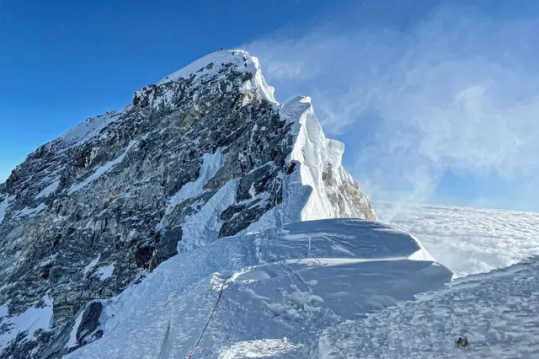
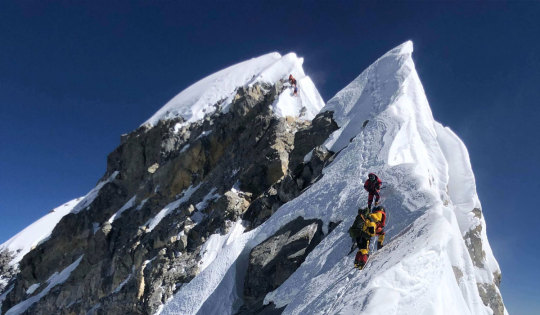
Why are Hundreds of Climbers Heading into the ‘Death Zone’ on Mt Everest This Spring?
Thick murky clouds fill the sky, with freezing winds carrying snow faster than 100 miles per hour. With a frigid –30 degrees Fahrenheit temperature, life-threatening snowstorms and avalanches are frequent.
And these are typical conditions on the world’s highest mountain: Mount Everest.
The behemoth towers 29,032 feet (8,849 meters) between Nepal and Tibet in the Himalayas, with its peak surpassing most clouds in the sky.
An attempt to climb Everest requires months, sometimes years, of training and conditioning – even then, reaching the summit is far from guaranteed. In fact, more than 300 people are known to have died on the mountain.
And yet the mountain still draws hundreds of climbers who are determined to reach its peak every spring. Here’s what it takes to make the climb and what has motivated some climbers to summit the world’s highest peak.
‘I thought I was in pretty good shape’
Dr. Jacob Weasel, a trauma surgeon, successfully summited Everest last May after conditioning for nearly a year.
“I would put on a 50-pound backpack and do two hours on a stair stepper with no problem,” Weasel said. “So, I thought that I was in pretty good shape.” However, the surgeon said he was humbled after discovering that his fitness was no match for the lofty athleticism required by the mountain.
“I would take five steps and have to take 30 seconds to a minute to catch my breath,” Weasel recalled of his struggle with the lack of oxygen available while ascending Everest.
Climbers aiming for the summit usually practice an acclimatizing rotation to adjust their lungs to the thinning oxygen levels once they arrive on the mountain. This process involves mountaineers traveling upward to one of the four designated camps on Everest and spending one to four days there before traveling back down.
This routine is repeated at least two times to allow the body to adapt to declining oxygen levels. It increases a climber’s chances of survival and summiting.
“If you took somebody and just plopped them up at the high camp on Everest, not even on the (top), they would probably go into a coma within 10 to 15 minutes,” Weasel said.
“And they would be dead within an hour because their body is not adjusted to that low of oxygen levels.”
While Weasel has successfully summited dozens of mountains, including Kilimanjaro (19,341 ft), Chimborazo (20, 549 ft), Cotopaxi (19,347 ft), and most recently Aconcagua (22,837 ft) in January, he said none of them compares to the high-altitude of Mount Everest.
“Because no matter how well you are trained, once you get to the limits of what the human body can take, it’s just difficult,” he continued.
At its highest altitude, Everest is nearly incapable of sustaining human life and most mountaineers use supplementary oxygen above 23,000 feet. The lack of oxygen poses one of greatest threats to climbers who attempt to summit, with levels dropping to less than 40% when they reach the Everest “death zone.”
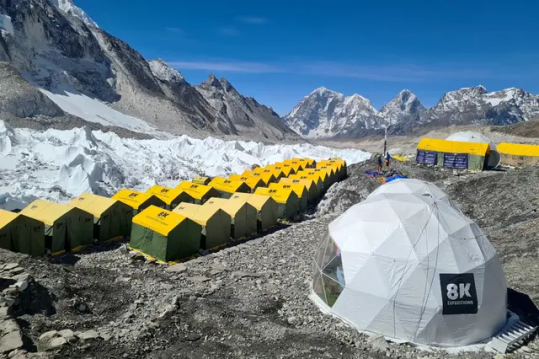
Tents of mountaineers are pictured at Everest base camp in the Mount Everest region of Solukhumbu district on April 18, 2024.
‘It’s difficult to survive up there’
The first target for mountaineers is Everest base camp at approximately 17,000 feet, which takes climbers about two weeks. Then they ascend to the three remaining camps stationed along the mountain.
Camp four, the final one before the summit, sits along the edge of the death zone at 26,000 feet, exposing climbers to an extremely thin layer of air, subzero temperatures, and high winds powerful enough to blow a person off the mountain.
“It’s difficult to survive up there,” Weasel said. He recalls passing bodies of climbers who died on the mountain – which isn’t uncommon. The bodies of the fallen mountaineers are well-preserved, exhibiting little to no decay due to the intense cold temperatures.
“I am probably more familiar with death and the loss of life than most people,” the surgeon said. “For me it was just a reminder of the gravity of the situation and the fragility of what life is… even more so motivation for appreciating the opportunity.”
High-altitude cerebral edema (HACE) is one of the most common illnesses climbers face while attempting to summit. “Your brain is starved of oxygen,” Weasel said.
HACE results in the brain swelling during its attempt to regain stable oxygen levels, causing drowsiness, trouble speaking and thinking. This confusion is often accompanied by blurred vision and sporadic episodes of delusion.
“I had auditory hallucinations where I was hearing voices [of friends] that I thought were coming from behind me,” Weasel recalled. “And I had visual hallucinations,” he added. “I was seeing the faces of my children and my wife coming out of the rocks.”
Weasel recalled crossing paths with a friend, Orianne Aymard, who was trapped on the mountain due to an injury. “I remember staring at her for like five minutes and just saying, ‘I’m so sorry,’” Weasel said.
“I’ve spent over a decade of my life training to help people as a surgeon, and being in a position where there’s somebody who requires your help and you are unable to offer any assistance… that feeling of helplessness was tough to deal with,” Weasel said.
Aymard survived. She was rescued and suffered from several broken bones in her foot, in addition to severe frostbite on her hands. Despite all her injuries, Aymard is considered one of the lucky ones.
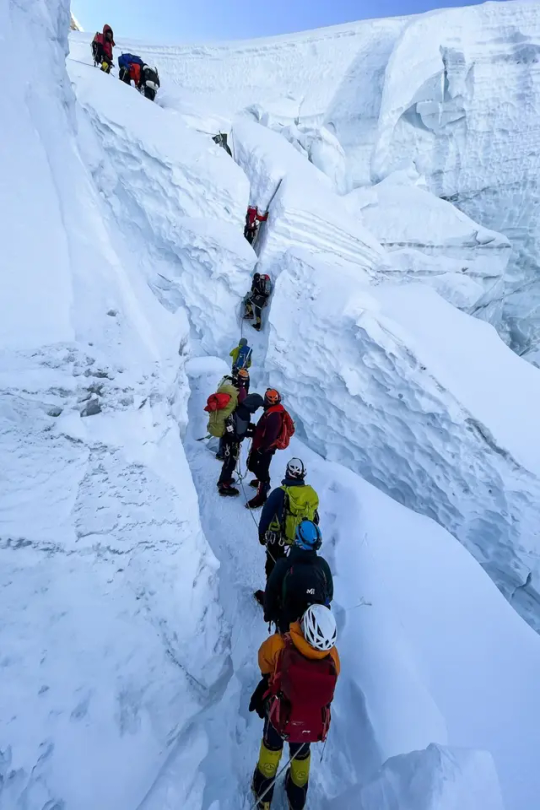
Mountaineers climbing during their ascend to summit Mount Everest on May 7, 2021.
‘Their bodies will get frozen into the mountain’
Everest has long been a tomb for climbers who have succumbed to harsh conditions or accidents on its slopes.
When a loved one or fellow climber is severely injured or dies on the mountain, it’s routine to leave them behind if you’re unable to save them, according to Alan Arnette, a mountaineer coach who summited Everest in 2014.
“What most teams do out of respect for that climber, they will move the body out of sight,” he said. And that’s only if they can.
“Sometimes that’s just not practical because of the bad weather, or because their bodies will get frozen into the mountain,” Arnette said. “So, it’s very difficult to move them.”
Seeing a corpse on Everest is comparable to seeing a horrible car accident, according to the mountain coach. “You don’t turn around and go home,” Arnette said. “You respectfully slow down… or say a prayer for that person, and then you continue.”
It’s been 10 years since the single deadliest accident on the world’s highest mountain, after an avalanche killed 12 Sherpa guides. And 2023 was recorded as the deadliest year on Everest, with 18 fatalities on the mountain – including five people that are still unaccounted for.
The process of recovering bodies is extensive, sometimes impossible. Helicopter rescues and search missions are challenging due to the high altitude and frequently treacherous conditions, resulting in some rescuers dying in their attempt to save others.
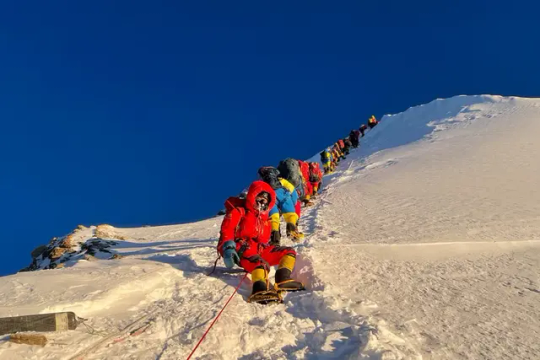
Mountaineers as they climb during their ascend to summit Mount Everest on May 12, 2021.
‘Watching the sunrise from 29,000 feet’
The 3,000 feet climb from camp four to the summit can take anywhere from 14 to 18 hours. Therefore, mountaineers typically leave the camp at night.
“That entire night was cold,” Weasel recalled. “It’s dark, it’s windy.” But it was proven to be worth it in the morning, he said.
“Watching the sunrise from 29,000 feet and having that pyramid of Everest’s shadow projected onto the valley below you…,” Weasel said. “It was probably one of the most beautiful things I’ve ever seen in my life,” he continued.
“It’s weird standing up there and knowing that everything else on the planet is below where you’re standing.”
The size of the mountain is humbling, the surgeon said. “I’ve never felt so small,” he recalled. “That mixture of humility and connectedness with something bigger than yourself is the proper place from which we ought to approach our existence on this planet.”
Like Weasel, Arnette summited at sunrise, and experienced this same feeling of “smallness.” At the top there were “more mountains than you can count,” Arnette remembered. “It was a sense of enormous gratitude and at the same time I knew I had to get back down.”
After about 20 minutes to an hour, climbers typically start to descend back to the base of the mountain.
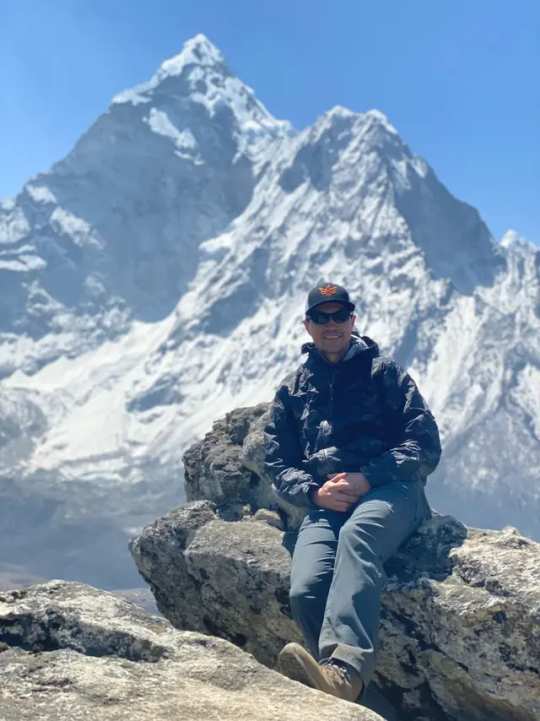
Jacob Weasel.
‘Bigger than yourself’
Before leaving for Nepal, Weasel was gifted an eagle’s feather as a beacon for his Native American heritage.
He was determined to plant the feather on top of Everest “as a symbol of our people and what we’ve endured for the past several hundred years,” Weasel said. “Showing that our spirit is not broken, but we’re able to rise above the things that have happened to us,” he added.
“I remember planting that eagle’s feather on the top of the world and the feeling of real privilege that I felt in representing our people.” And this is why he decided to summit Everest, to be an example that anything is possible for young Native children and his tribe.
“Knowing what it’s like up there, for me personally, the only real justification for going and putting your life, and other lives, at risk is if you’re climbing for a reason that is much bigger than you,” said Weasel.
Arnette attempted to climb Everest three times before he successfully summited.
“My first three tries, I wasn’t clear on my why,” Arnette said. When his mother was diagnosed with Alzheimer’s disease, he looked at his purpose for climbing differently.
“I wanted to do it to raise money for Alzheimer’s and honor my mother,” Arnette said.
There are approximately 300 people that have been issued a permit from the Nepal government to climb the mountain this year, according to Arnette. And he said the number is down from previous years.
“I think one of the reasons is because we had the 18 deaths last year, and people realize that Mount Everest is a dangerous mountain.”
However, he doesn’t believe that should deter climbers from attempting to summit. “I’m a big believer that when you go climb these mountains that you come home a better version of yourself,” Arnette said.
“Everest has become too commercialized with ‘you’re stepping over dead bodies’ and ‘it’s littered with trash,’” the mountain coach said. “The reality is that it is a very small degree all of that, but there’s a lot of joy that people get out of doing it,” he continued.
“And that’s the reason that we climb mountains.”
By Kara Nelson.
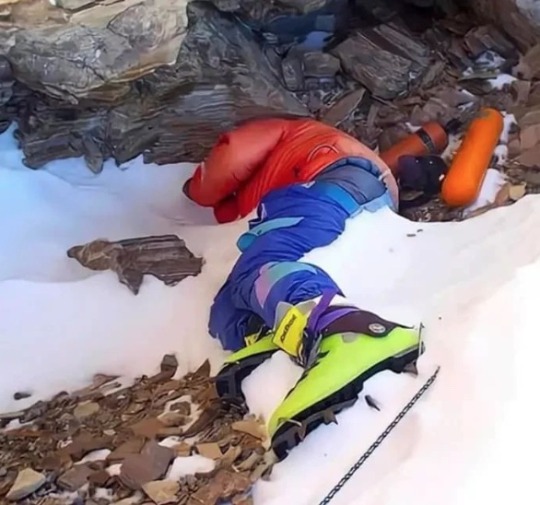
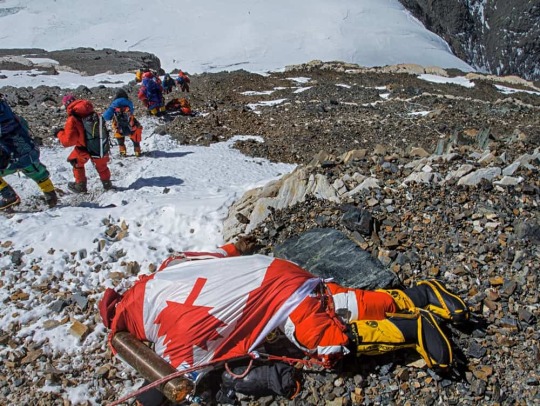
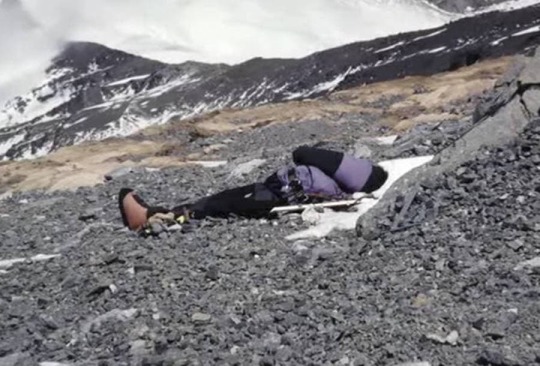
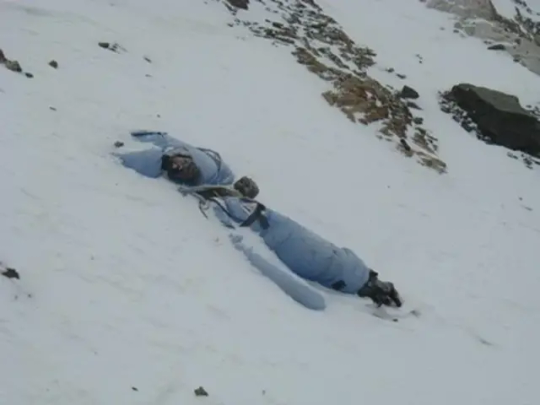
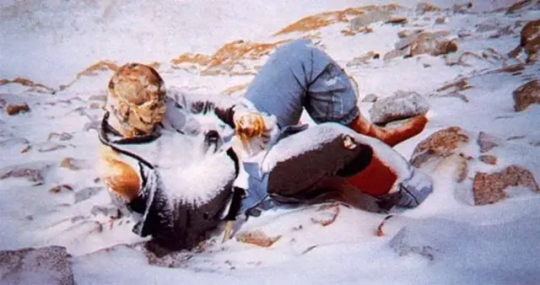
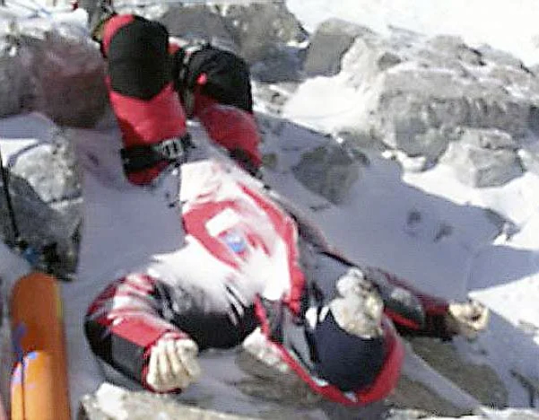
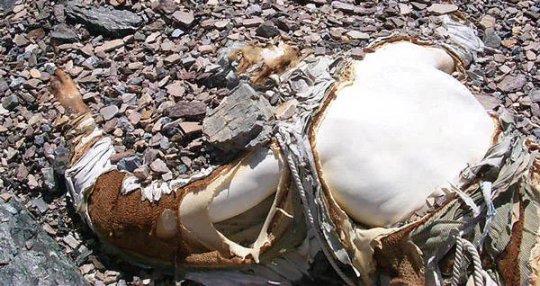


#Mt Everest#Mount Everest#Everest#The Death Zone#Why are Hundreds of Climbers Heading into the ‘Death Zone’ on Mt Everest This Spring?#world’s highest mountain#the Himalayas#mountain climbing#death on a mountain#history#history news#long reads#long post#long story
34 notes
·
View notes
Text
The Nepalese army says it has removed eleven tonnes of rubbish, four corpses and one skeleton from Mount Everest and two other Himalayan peaks this year.
It took troops 55 days to recover the rubbish and bodies from Everest, Nuptse and Lhotse mountains.
It is estimated that more than fifty tonnes of waste and more than 200 bodies cover Everest.
The army began conducting an annual clean-up of the mountain, which is often described as the world’s highest garbage dump, in 2019 during concerns about overcrowding and climbers queueing in dangerous conditions to reach the summit.
The five clean-ups have collected 119 tonnes of rubbish, 14 human corpses and some skeletons, the army says.
This year, authorities aimed to reduce rubbish and improve rescues by making climbers wear tracking devices and bring back their own poo.
In the future, the government plans to create a mountain rangers team to monitor rubbish and put more money toward its collection, Nepal's Department of Tourism director of mountaineering Rakesh Gurung told the BBC.
For the spring climbing season that ended in May, the government issued permits to 421 climbers, down from a record-breaking 478 last year. Those numbers do not include Nepalese guides. In total, an estimated 600 people climbed the mountain this year.
This year, eight climbers died or went missing, compared to 19 last year.
A Brit, Daniel Paterson, and his Nepalese guide, Pastenji Sherpa, are among those missing after being hit by falling ice on 21 May.
Mr Paterson’s family started a fundraiser to hire a search team to find them, but said in an update on 4 June that recovery “is not possible at this time” because of the location and danger of the operation.
Mr Gurung said the number of permits was lower this year because of the global economic situation, China also issuing permits and the national election in India which reduced the number of climbers from that country.
The number of permits will likely drop more after Nepal’s Supreme Court ordered the government in May to limit permits. The preliminary order didn't set a maximum number.
Mr Gurung says he welcomes the order and the government is thinking about reforms such as staggering climbers to reduce traffic jams at the summit.
#mount everest#environmentalism#science#environment#nature#himalayas#good news#trash#nepal#pollution
18 notes
·
View notes
Text
DAY 5525
Jalsa, Mumbai Apr 2, 2023 Sun 11:49 PM
Birthday Ef
🪔 .. April 03 .. birthday wishes to Ef Haarsha Balraj from South Africa .. Ef Krishna urf Kris Dwivedi from Bilaspur CG .. and Ef Divyansh Rawat from Lucknow .. love and happiness .. ❤️❤️❤️🌿 and all the good wishes from the family Ef .. and the Sunday meetings at the Gate be in preference of course .. hence here

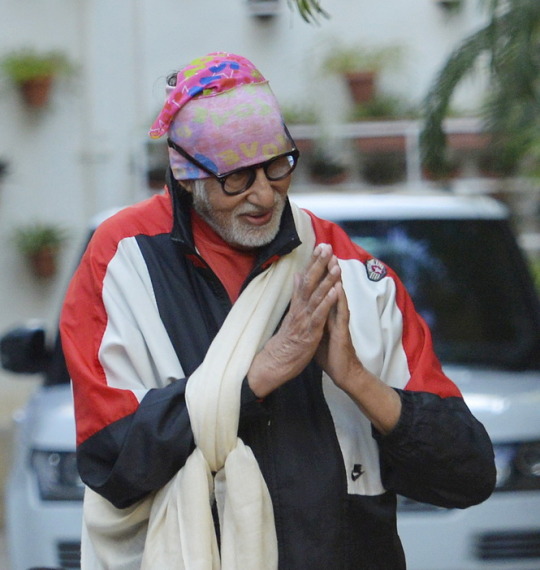





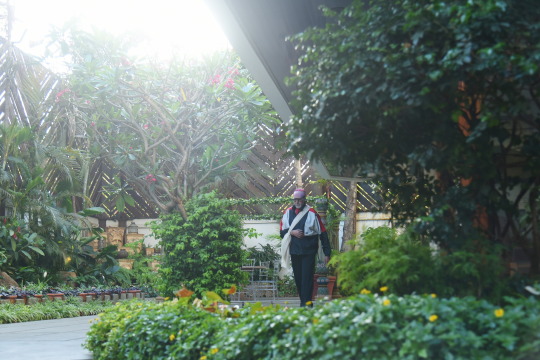



And the very revealing aspect for the coming day be that on April 3, for the first time an adventure took place .. the first plane to fly over the Everest .. in the year 1934 , apparently ..
Justification :
📌 .. and on this day .. April 3, 1933 .. conquering the impossible .. happened the first fly ever over Everest 🏔️ .. by two British aircraft of type Westland Wallace bi-planes .. crewed by Squadron Leader Douglas-Hamilton and Colonel LVS Blacker in one and Flight Lieutenant MacIntyre and Mr SR Bonnet in the other .. they took off from Lalbalu aerodrome, near Purnea, India .. the flight lasted for around three hours, covered a return distance of 320 miles reaching nearly 30,000 feet clearing the mountain by a reported 100 feet .. close range photographs of Mt Everest proved the achievement which previously was not possible to any airplane ..
further justification -




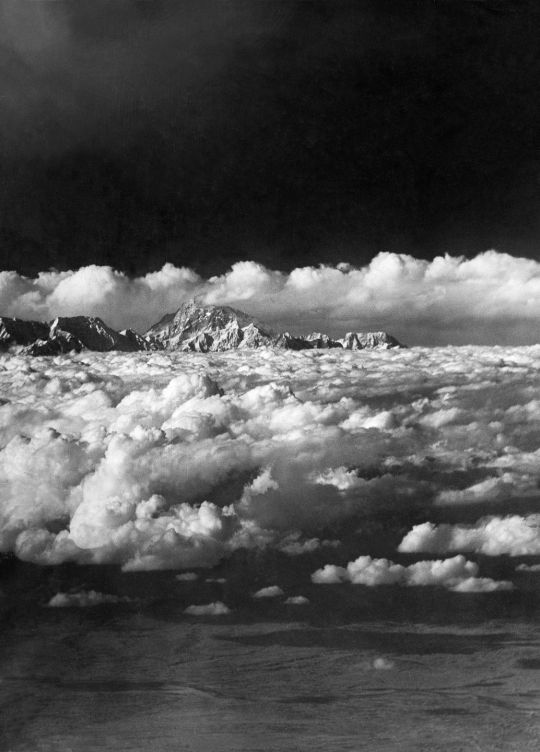

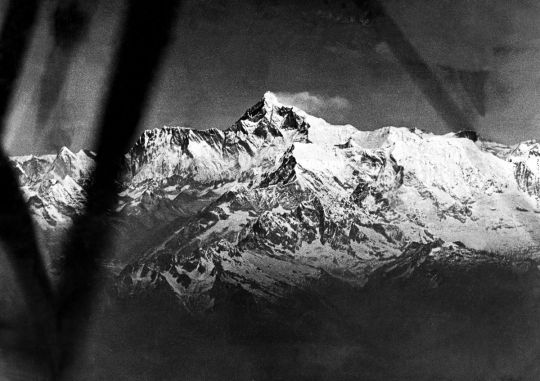
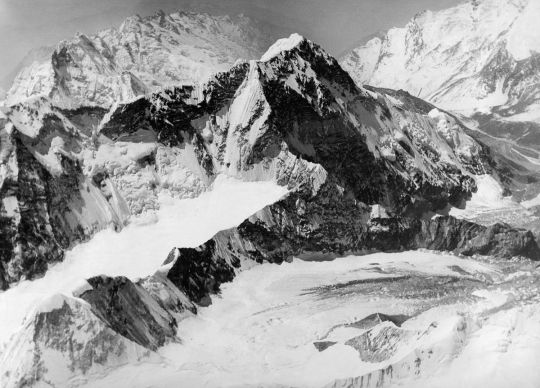
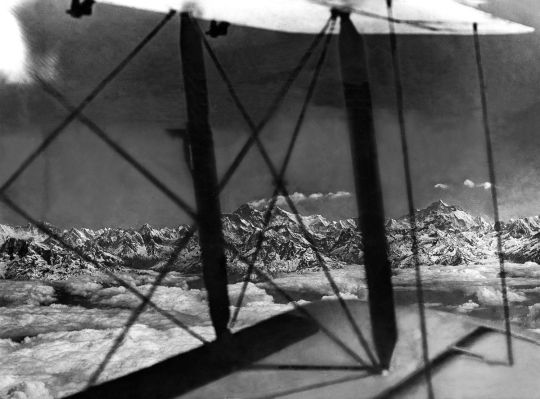
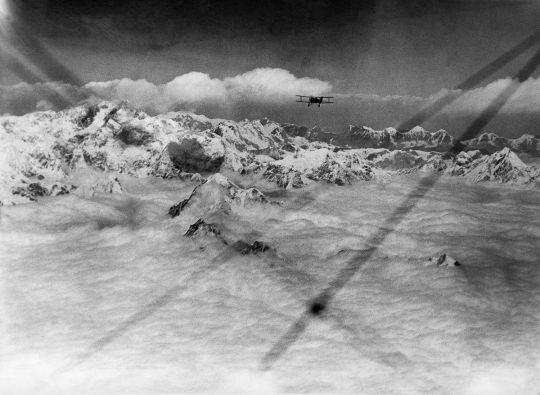



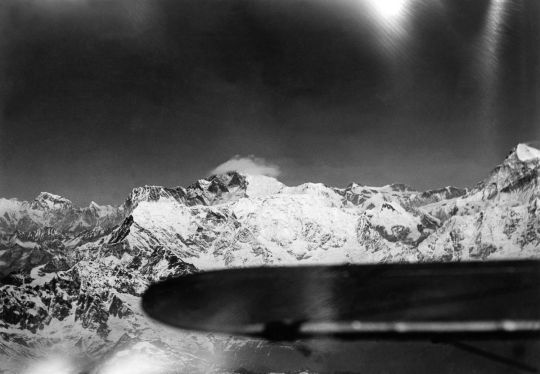


the peak , the highest point on Earth .. the mountain , the Himalayas and the feat that seems to this generation to be no big deal, because they are unaware of the conditions and circumstances that prevailed then ..
Everest .. named by the British when they ruled over India ..
In the nineteenth century, the mountain was named after George Everest, a former Surveyor General of India. The Tibetan name is Chomolungma, which means “Mother Goddess of the World.” The Nepali name is Sagarmatha, which has various meanings.
Sagarmatha .. ‘sagar’ , the Ocean .. ‘matha’ churning .. and the Indian mythology that the Oceans were churned by the mountain to produce the ‘amrit’ ..
my interpretation .. though the knowledge from the records says this :
Sagarmatha is a Sanskrit word, from sagar = "sky" (not to be confused with "sea/ocean") and matha = "forehead" or "head", and is the modern Nepali name for Mount Everest.
the Goddess of the Sky .. in Tibet it is addressed as
Therefore, the historic, local Tibetan name for Mount Everest is Chomolungma, also spelled Qomolangma, meaning "Goddess Mother of the World." Chomolungma is pronounced "CHOH-moh-LUHNG-m?." The Nepali name for Mount Everest is Sagarmatha, meaning "Godess of the Sky." Some refer to the entire massif of peaks as ...
and the many adventure stories on the Sagarmatha prevail ..
And the great thrill at the time of a shooting in Nepal, when I went on a plane that flew us right next to the Everest and the experience almost unreal ..
Such be the moments of remembrance ..
It was a touristy matter and many such flights I do believe operate from Kathmandu, Nepal for the pleasure of tourists .. even now ..
Its majesty has never reduced despite the conquering of it by several now .. and the very sight of which evokes so much wonder .. the wonder of the Gods .. the makers that introduced us to us all .. and the reason of its formation .. that the entire subcontinent now known as India was a part of the continent of Africa, at Egypt .. and many millions of years ago the entire subcontinent broke away from the mother board and shifted travelled over the Indian Ocean, to the Eastern sub continent and attached itself there .. the impact of the joining of the land mass being so great , it formed the realm, now known as the Himalayas !!
I do not have authenticity on this , but it does seem to be believed , historically and geographically .
and the day in recuperation and the meeting at the Gate , of the ever present well wisher ..
Amitabh Bachchan
and the signature above out of place , because the icon that opens the Desktop to search the sign is JUST not appearing ..
and this has been on several times before too ..
this model of the updated Mac, the Ventura is absurd and has created many problems ..
deliberately done to attract more when the changed model is brought out ?? marketing and manufacturing often does that .. the deliberation to access the mode of investing in the latest and doing away with the present ..
154 notes
·
View notes
Photo

Mountains in the Contiguous U.S. by Rise Above Surroundings / Jut
by u/Gigitoe
Jut is an indicator I developed to quantify how sharply/impressively a mountain rises above its surroundings, factoring in both height and steepness. A mountain with a jut of X rises as sharply/impressively as a vertical cliff of height X. Roughly speaking, the higher the jut, the "bigger" and more imposing a mountain appears.
Some things to note:
Jut hotspots (places with the most impressive mountains) include the Cascade Range, North Cascades, Glacier National Park, Grand Teton National Park, Yosemite National Park & Central/Southern Sierra, and Mount San Jacinto. The highest jut in the lower 48 is measured atop Mount Rainier (jut = 1312 m), a massive stratovolcano in the Cascade Range of Washington.
Even though the Colorado Rockies have a high elevation, they have a lower jut than some other mountain ranges in the West, as they rise from a high plateau. The Grand Canyon in Arizona has similar local rise as the highest peaks of the Colorado Rockies, despite having a much lower elevation.
A point with a jut of 10 – 100 m is perhaps more aptly described as a hill. Points with a jut below 10 m do not rise significantly above their surroundings, so they were not included.
Mountains in the rest of the world can have a significantly higher jut. The Matterhorn in the Swiss Alps has a jut of 1451 m. Aconcagua in the Andes of Argentina has a jut of 1827 m. Mount Everest has a jut of 2211 m. The North Peak of Denali in Alaska has a jut of 2549 m. Annapurna Fang in Nepal, the apex of the biggest mountain face on the planet, has a jut of 3395 m, the highest in the world.
This visualization was made possible with Google Earth Engine, MERIT DEM, GeoNames, and QGIS.
136 notes
·
View notes
Photo
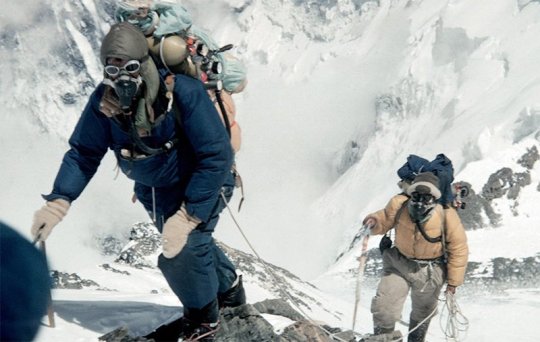
If you only do what others have already done, you will only feel what others have already felt. However, if you choose to achieve something that no one has ever done, then you will have a satisfaction that no one else has ever had.
- Sir Edmund Hillary
Sir Edmund Hillary of New Zealand and Tenzing Norgay, a Sherpa from Nepal, made history as the first individuals to conquer the summit of Mount Everest.
The image captures them near Camp IX in Nepal, just one day before reaching their ultimate goal. This monumental achievement took place on 29 May 1953, concluding a long-standing quest to conquer the world's highest peak.
Their triumph symbolises the indomitable human spirit and the collaborative efforts of countless explorers who dared to challenge the unconquerable.
#hillary#edmund hillary#quote#tenzig norgay#everest#mountaineering#mount everest#mountaineers#endurance#pioneers#perserverance#courage#nepal#human spirit#nature
72 notes
·
View notes
Text
Conquer the Himalayas: A Trekker’s Dream Adventure
The Himalayas, often referred to as the "Roof of the World," is a breathtaking mountain range that stretches across five countries: India, Nepal, Bhutan, China, and Pakistan. Known for its stunning landscapes, rich biodiversity, and profound cultural heritage, the Himalayas beckon travelers from around the globe. If you’re seeking an adventure that combines natural beauty, spiritual enrichment, and thrilling experiences, a Himalayan Tour Package is the perfect choice for you. This article explores the various aspects of traveling to this majestic region and why a Himalayan tour should be on your travel bucket list.
Why Choose a Himalayan Tour Package?
When it comes to exploring the Himalayas, opting for a Himalayan Tour Package has numerous advantages. Firstly, a well-curated package takes care of all the logistics, allowing you to focus on experiencing the beauty and culture of the mountains. From accommodations to meals, transportation, and guided tours, everything is planned for you. This not only saves you time but also ensures a seamless experience, especially in a region where navigating the terrain can be challenging.
Additionally, a Himalayan Tour Package often includes experienced guides who are well-versed in the local culture and geography. They can provide insights and stories that enhance your understanding of the places you visit, making your journey even more enriching.
Destinations to Explore
The Himalayas are home to numerous breathtaking destinations, each offering unique experiences. Some of the must-visit places included in most Himalayan Tour Packages are:
Leh-Ladakh: Famous for its rugged terrain and stunning landscapes, Leh-Ladakh is a paradise for adventure enthusiasts. From the serene Pangong Lake to the thrilling Khardung La Pass, the region offers plenty of trekking, camping, and biking opportunities.
Manali: Nestled in the Kullu Valley, Manali is a popular hill station known for its picturesque landscapes and vibrant culture. A Himalayan Tour Package to Manali typically includes visits to Solang Valley, Rohtang Pass, and the ancient Hadimba Temple.
Shimla: The capital of Himachal Pradesh, Shimla is renowned for its colonial architecture and panoramic views. Visitors can stroll along the Mall Road, visit the Christ Church, and explore the surrounding hills.
Rishikesh and Haridwar: Known as the spiritual hubs of India, Rishikesh and Haridwar attract pilgrims and adventure seekers alike. A Himalayan Tour Package to this region often includes yoga retreats, river rafting, and visits to ancient temples.
Nepal: The Himalayan range in Nepal is home to some of the highest peaks in the world, including Mount Everest. Trekking packages to Everest Base Camp and Annapurna Circuit are popular among adventure lovers.
Cultural Experiences
One of the highlights of a Himalayan Tour Package is the opportunity to immerse yourself in the local culture. The region is home to a diverse range of communities, each with its own traditions, festivals, and cuisines. Whether you’re attending a local festival, participating in a traditional dance, or enjoying a meal with a local family, you’ll find that the hospitality of the Himalayan people is unmatched.
Many Himalayan Tour Packages also include visits to ancient monasteries and temples. These sacred sites offer a glimpse into the spiritual life of the region and are often located in breathtaking settings, surrounded by towering peaks and lush valleys.
Adventure Activities
For adventure enthusiasts, the Himalayas are a playground offering a myriad of activities. From trekking and mountaineering to paragliding and river rafting, a Himalayan Tour Package can be tailored to suit your adventurous spirit.
Trekking: The Himalayas boast some of the best trekking routes in the world. Popular treks include the Triund Trek, Valley of Flowers, and the Everest Base Camp Trek. Each trek offers stunning vistas and a chance to connect with nature.
Paragliding: For those seeking an adrenaline rush, paragliding in places like Bir Billing and Manali provides an exhilarating experience of soaring above the mountains.
River Rafting: The rivers flowing down the Himalayan slopes offer thrilling white-water rafting opportunities. Rishikesh is particularly famous for its rafting adventures.
Skiing and Snowboarding: During winter, regions like Auli and Gulmarg transform into winter wonderlands, attracting skiing and snowboarding enthusiasts.
Best Time to Visit
Choosing the right time for your Himalayan Tour Package is essential to ensure a pleasant experience. The best time to visit the Himalayas largely depends on the specific region and the activities you wish to pursue:
Summer (March to June): This is the peak season for travelers, especially for trekking and outdoor activities. The weather is pleasant, and the landscapes are lush and green.
Monsoon (July to September): While the monsoon brings vibrant greenery, it can also lead to landslides and travel disruptions in some areas. However, this is a great time for cultural festivals.
Autumn (October to November): Autumn is another excellent time to visit, with clear skies and breathtaking views. The temperatures are cooler, making it perfect for trekking.
Winter (December to February): Winter in the Himalayas offers a unique charm, especially for those interested in snow sports. However, be prepared for colder temperatures and potential road closures.
Conclusion
A Himalayan Tour Package promises an unforgettable journey through one of the most breathtaking landscapes on Earth. With its stunning vistas, rich cultural experiences, and adventure opportunities, the Himalayas are a destination that truly has something for everyone. Whether you’re looking for spiritual enlightenment, thrilling adventures, or simply a break from the hustle and bustle of daily life, the majestic Himalayas await your exploration. So pack your bags and get ready to embark on an incredible journey to the roof of the world!
2 notes
·
View notes
Text
History And Origin of Nepal: A journey through time
Lying right in the middle of the Himalayas between India and China, Nepal is a country that is full of a whole of history. The story it tells is of myths, legends, dynasties, and influences that flowed on the waves of both the Indian subcontinent and the Tibetan plateau. The origin of Nepal seems to be completely intertwined with geographical elements, religion, and cultural heritage. In this blog, one is introduced to the historical journey of Nepal and formation of Himalayas, from its root to the formation of a modern nation.
Mythological Beginnings: Legends of Nepal's Formation
The history of Nepal opens with mythological accounts about the origin. Ancient legends say that Kathmandu Valley was once a huge lake, inclusive of what today is considered the cultural and historical heart of Nepal. According to this, a Buddhist saint called Manjushree, coming from China, saw a lotus flower falling in the middle of the lake and wanted to reach it. At Chobar, he cut a gorge with his sword thereby allowing it to drain the water so that the valley could be habitable. Thus, the fertile land of the Kathmandu Valley came into being. This mythical event is symbolic of the birth of Nepal. Another popular legend describes how the god Vishnu, in the avatar of a boar, or Varaha, raised Nepal out of the waters. These myths said much not only about how the people of Ancient Nepal viewed their land but also revealed the deep religious meaning always permeating Nepalese culture.
Unification of Nepal: The Rise of the Shah Dynasty
Nepal’s political landscape changed dramatically in the 18th century with the rise of Prithvi Narayan Shah, the ruler of the small principality of Gorkha. He embarked on a campaign to unify the various fragmented kingdoms and principalities of the region. After several attempts, Prithvi Narayan Shah successfully conquered the Kathmandu Valley in 1768, marking the beginning of the Shah dynasty and the creation of modern Nepal. Prithvi Narayan Shah's unification campaign laid the foundation for a strong, centralised kingdom. He strategically kept Nepal independent from both the expanding British Empire in India and the Qing Dynasty in China by maintaining a policy of isolation and diplomacy.
The Collision of India and Eurasia: Birth of the Himalayas
Nepal is home to Himalayas: the home to world's highest peaks, including Mt. Everest.The story of the Himalayas really started when the Indian subcontinent, shortly after it broke away from Gondwana around 100 million years ago, began its drift northward. There laid between the Indian plate and the Eurasian plate at that time the Tethys Ocean. In this process, the Indian plate was submerged underneath the Eurasian plate, and it is both slow and powerful. These movements created strong geological forces which pushed up the sedimentary rocks of the Tethys Ocean, hence creating the Himalayan mountain range. The impact of the collision caused the Earth's crust to fold, that formed the towering peaks of the Himalayas. The immense pressure created large thrust faults, which caused the land to rise vertically. Over time, these processes built some of the highest mountains in the world, including Mount Everest (8,848 meters) and Kangchenjunga (8,586 meters), both of which are located in the Nepalese Himalayas.
Geological Zones of the Nepal Himalayas
The Nepalese Himalayas were divided into a number of distinct geological zones, which reflect their complex history of formation. These include the following:
Terai Plains: This is a flat, fertile region situated on the southernmost part of Nepal, marking the northern edge of the Indo-Gangetic plains. They actually were formed by sediments deposited by the rivers flowing down from the Himalayas.
Siwalik Hills: Lying just north of the Terai, Siwalik Hills are the youngest part of the Himalayas that were uplifted about 10 to 20 million years ago. It is a folded and faulted rock area which has been uplifted relatively recently.
3.The Mahabharat Range: This range lies north of Siwalik, much older, loftier, and with steeply descending slopes enclosing profound valleys. Metamorphic and sedimentary rocks common in this region bear the telltale presence of the gradual uplift that has occurred here over millions of years.
4.Lesser Himalayas: This zone lies north of the Mahabharat Range and consists of a series of hills and ridges that rise up to about 4,000 meters. The Lesser Himalayas are made up of older rocks, mainly sedimentary and metamorphic uplifted during the early phase of collision between the Indian and Eurasian plates.
5.Greater Himalayas: Higher or Greater Himalayas forms the central backbone of this mountain and contains all the highest peaks including Mt. Everest and Kangchenjunga. Ancient metamorphic rocks, mainly schist and gneiss, are dominant in this zone, which has undergone extreme heat and pressure for millions of years.
6.Tibetan Plateau: The Tibetan Plateau forms the northern boundary of the Greater Himalayas, and is rightly called the "Roof of the World." This high-altitude plateau, in turn, had been raised as the Indian plate moved northward and was thrust underneath the Eurasian plate.
Thus, the history of Nepal represents a tapestries history with myths, conquests, cultural achievements, and political upheavals. Starting from the mythological beginnings down to its present-day status as a republic.The history of the Himalayas in Nepal is a long geology that has taken millions of years to unfold. From the first collision between the Indian and Eurasian plates to the towering peaks that now define the region, the Himalayas remain a living testimony to the dynamic forces shaping our planet. That spectacle of beauty and grandeur, yet at the same time a grim reminder of the immense power of nature and the precarious balance between the geological processes of Earth and the fragile ecosystems which find life in their shadow. Nepal's journey through history has taken a path no less dramatic than the landscape it inhabits. As the nation continues to grow, its past shapes its future, guided by the aspirations of the people that populate it.
2 notes
·
View notes
Text
Gokyo Valley Trek
The Gokyo Valley Trek is a stunning adventure in the Everest region of Nepal, offering breathtaking views of the world’s highest peaks. This trek takes you through serene valleys, vibrant Sherpa villages, and the mesmerizing turquoise Gokyo Lakes. A highlight of the journey is the climb to Gokyo Ri, from where you can witness panoramic views of Everest, Lhotse, Makalu, and Cho Oyu. Less crowded than the classic Everest Base Camp route, the Gokyo Valley Trek provides a unique and peaceful experience for trekkers seeking both natural beauty and cultural immersion.
2 notes
·
View notes
Text


The Himalayas, with Mount Everest at top center, captured by satellite at a low angle. The range contains some of Earth’s highest peaks, including over 100 that exceed 23,600 feet (7,200 meters) in elevation. The Himalayas abut or cross five countries: Bhutan, India, Nepal, China, and Pakistan.
Source imagery: Planet
474 notes
·
View notes
Text
How long does it take to climb Manaslu?
The eighth-highest peak in the world, Manaslu, is a spectacular climb. Standing at a height of 8,163 meters (26,781 ft), it is situated in Nepal. You may be wondering how long it takes to reach the top if you're considering taking on this adventure. Now let's dissect it!
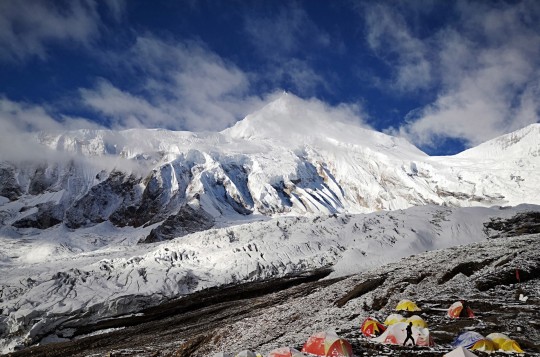
Preparation: Training and Planning
It's important to prepare before you ever set foot on the mountain. The majority of climbers train their bodies and minds for several months. Typically, this comprises:
Physical Training: Building strength, endurance, and flexibility.
Mental Preparation: Developing the mental toughness to handle extreme conditions.
Logistics: Organizing permits, gear, and a reliable guiding service.
Journey to Base Camp
Travel to Kathmandu, the capital of Nepal, is the first leg of the trek to Manaslu Base Camp. You will next drive to the trailhead, which is usually in Soti Khola or Arughat. This is a six to seven-hour drive. After that, you'll journey through stunning communities and scenery for roughly six to ten days. Acclimatization, or assisting your body in adjusting to the altitude, is facilitated by this walk.
Acclimatization and Climbing
Once at Base Camp, the real adventure begins. Here's a rough timeline:
Week 1: Base Camp and Acclimatization
Days 1-3: Setting up Base Camp and resting.
Days 4-7: Acclimatization hikes to higher altitudes and returning to Base Camp.
Weeks 2-3: Climbing Rotations
Days 8-14: Climbing to higher camps (Camp 1, Camp 2, Camp 3) and returning to Base Camp for rest. This helps your body get used to the thin air.
Days 15-21: More rotations between camps, gradually moving higher each time.
Week 4: Summit Push
Days 22-28: Weather permitting, you make your summit push. This involves:
Climbing from Base Camp to Camp 1, then Camp 2, Camp 3, and finally Camp 4.
From Camp 4, you'll start your summit attempt, often in the early hours before dawn. The climb from Camp 4 to the summit and back to a lower camp can take about 12-18 hours.
Descent and Return
Although the descent is faster after reaching the summit, caution is still necessary. Usually, returning to Base Camp takes three to four days. After spending another five to seven days trekking from Base Camp to the trailhead, one can drive back to Kathmandu.
Total Time
In total, the entire expedition from Kathmandu and back usually takes around 6-8 weeks. This includes time for acclimatization, climbing rotations, and weather delays.
Personal Experience
The experience of climbing Manaslu was both thrilling and draining. There were breathtaking vistas and hospitable residents along the route to Base Camp. Although difficult, the acclimatization climbs were necessary to help the body adjust to the high altitude. The most difficult part was pushing to the summit while dealing with bitter cold and strong gusts. It was all worthwhile, though, as you stood atop the peak and gazed down at the world below.
Final Thoughts
Manaslu climbing is a challenging but worthwhile experience. It calls for endurance, patience, and careful planning. Manaslu presents a special challenge that will make you cherish your time spent there, regardless of your level of experience as a mountaineer or your level of desire for exploration.
2 notes
·
View notes
Text
Off-the-Beaten-Path Treks in Nepal - Less-Crowded Hiking Trails

Nepal, renowned for its iconic Himalayan treks like the Everest Base Camp and Annapurna Circuit, is a paradise for adventurers. But beyond these well-trodden paths lie hidden gems – lesser-known treks that offer a chance to explore remote villages, pristine landscapes, and untouched wilderness. In this blog, we'll take you on a journey to discover some of Nepal's off-the-beaten-path treks that are sure to take your breath away.
1. The Upper Dolpo Trek:

Tucked away in the far-flung corners of western Nepal, the Upper Dolpo region is a hidden gem waiting to be discovered. This remote trek takes you through rugged terrain, deep river gorges, and ancient Tibetan villages, offering a glimpse into a way of life that has remained unchanged for centuries.
Highlights of the Upper Dolpo trek include the stunning Phoksundo Lake, one of the deepest lakes in Nepal, surrounded by dramatic cliffs and crystal-clear waters. You'll also have the opportunity to visit the centuries-old Shey Gompa, perched high on a hillside overlooking the valley below. With its rich cultural heritage and breathtaking scenery, the Upper Dolpo trek is truly a once-in-a-lifetime adventure.
2. The Tsum Valley Trek:

Nestled between the majestic Ganesh Himal and Sringi Himal ranges, the Tsum Valley is a hidden sanctuary of tranquility and beauty. This off-the-beaten-path trek takes you through remote villages, terraced fields, and lush forests, offering a glimpse into the traditional Tibetan way of life.
One of the highlights of the Tsum Valley trek is the opportunity to visit ancient Buddhist monasteries, including the Milarepa Cave, where the legendary Tibetan saint is said to have meditated. You'll also have the chance to soak in natural hot springs, surrounded by snow-capped peaks and pristine wilderness. With its peaceful atmosphere and stunning scenery, the Tsum Valley trek is a hidden gem waiting to be discovered.
3. The Kanchenjunga Base Camp Trek:

Located in the easternmost corner of Nepal, the Kanchenjunga region is home to some of the most remote and unspoiled wilderness in the country. The Kanchenjunga Base Camp trek takes you on a journey through dense forests, alpine meadows, and glacial valleys, with panoramic views of the world's third-highest peak, Mt. Kanchenjunga.
Highlights of the Kanchenjunga Base Camp trek include the stunning views from the Pangpema viewpoint, where you can see the entire Kanchenjunga massif stretching out before you. You'll also have the chance to explore traditional Rai and Limbu villages, and immerse yourself in the rich cultural heritage of the region. With its pristine landscapes and remote wilderness, the Kanchenjunga Base Camp trek is a hidden gem that offers a true sense of adventure.
4. The Manaslu Circuit Trek:

Situated in the shadow of the towering Mt. Manaslu, the eighth highest peak in the world, the Manaslu Circuit trek is a hidden gem that rivals its more famous counterparts in the Annapurna and Everest regions. This challenging trek takes you through remote villages, high mountain passes, and dramatic landscapes, offering unparalleled views of the Himalayan giants.
Highlights of the Manaslu Circuit trek include the opportunity to cross the Larke Pass, one of the highest mountain passes in Nepal, and visit the ancient Buddhist monasteries of Samagaon and Samdo. You'll also have the chance to witness the unique culture and traditions of the indigenous Tibetan people who call this region home. With its rugged beauty and cultural richness, the Manaslu Circuit trek is a hidden gem waiting to be explored.
Conclusion:
While Nepal is famous for its iconic Himalayan treks, the country also boasts a wealth of off-the-beaten-path trails that offer a chance to explore remote villages, pristine landscapes, and untouched wilderness. From the remote valleys of Upper Dolpo to the hidden sanctuary of the Tsum Valley, these hidden gems are sure to take your breath away with their stunning beauty and cultural richness. So lace up your boots, pack your bags, and get ready to embark on the adventure of a lifetime in the hidden corners of Nepal.
Glorious Himalaya Trekking Pvt. Ltd. is an authentic local tour company based in Kathmandu, Nepal, specializing in multi-day tours for solo and private groups. You can contact them through [email protected] or WhatsApp: +977-9813637616.
#travel#trekking in nepal#adventure#hiking#mountains#himalayas#holidays#nepal#trekking#tours#off the beaten trek
2 notes
·
View notes